Here are some of the views as we drove up out of the tropical lowlands to the resort itself.
Once we arrived, a good deal of our sessions were indoors, but there were, of course, several field excursions for the trainees over the two days of the workshop.
Much of our field work took place in the shadow of Gunung Penrissen, near the Indonesian border.
The mowed stretch along the overlook let the birders keep an eye on the forest behind the viewpoint, and watch for other birds flying over border or moving through the shrubbery on the steep slope running down from the Indonesian side.
It was hard to avoid, of course, simply enjoying the view from the overlook itself...
Even if, among the expanses of forest, we could see alarming signs of deforestation on the Indonesian side.
Here, Dr. Hans Hazebroek, one of our instructors and the author of National Parks of Sarawak and other vital books of Bornean natural history, trains his spotting scope over the border, while his wife and MNS stalwart Cynthia Lobato checks her camera.
The overlook is a good place for birds of prey, and in particular Blyth's Hawk-Eagle (Nisaetus alboniger).
Bird photography can be tricky here; birds like this Bornean Brown Barbet (Caloramphus fuliginosus) tend to stay in the treetops.
That is also my excuse for the less-than stellar quality of this photo of a Black-and-yellow Broadbill (Eurylaimus ochromalus).
I had more luck (although this was, after all, a training session for birders) using my spare moments to photograph other things. Borneo Highlands is, for example, full of interesting and often beautiful plants.
This is a climbing pandanus (probably a member of the related genus Freycinetia, most of whose members are climbers), its stems stretched out against the sky.
The graceful curve of a fiddlehead always makes an attractive (and because it holds still and allows close approach, cooperative) subject.
Borneo Highlands is a good spot for squirrel-watching. A number of interesting species live up here, including this Black-eared Pygmy Squirrel (Nannosciurus melanotis) working over the bark of a large overhanging limb.
Low's Squirrel (Sundasciurus lowi) is one of a group of similar small squirrels. I am calling this one a Low's based on its whitish belly and fairly short, bushy tail. Like the Black-eared Pygmy Squirrel, it is an animal of lowlands and foothills, and may be near the upper end of its altitudinal range at Borneo Highlands.
This plain little butterfly, perched on a lichen-covered rock, is obviously one of the blues, but I do not know which one.
Over our lunch break I had time to check out the ponds and rivulets around the lodge for dragonflies and damselflies. The lily pond outside the dining hall was also home to Green Paddy Frogs (Hylarana erythraea).
The two common local Trithemis species were much in evidence, including the deep pink T. aurora.
Trithemis dragonflies, though (as the lower photo shows) they frequently perch on vegetation, seem to prefer rocks, especially if they border watercourses.
This is the other common species, the dark blue Trithemis festiva.
I found numbers of the common blue dragonfly Orthetrum glaucum...
...as well as a few of its strikingly bicoloured cousin Orthetrum pruinosum, particularly around heavily-vegetated small ponds by the roadside.
The small rocky streams cross-crossing the golf course at Borneo Highlands are good places to look for damselflies. One of the commonest is Euphaea subcostalis, which you can almost almost find perching on a convenient rock on the streambed...
...or on a bit of vegetation nearby. It appears to be the only Euphaea in the area.
Heliocypha biseriata is also common here, as it is at lower elevations.
Vestalis damselflies almost invariably perch on the edges of leaves, whether overhanging the water or not. Identifying them to species pretty much requires having them in hand, preferably with a stereo microscope handy, to check out details of the genitalia. These two, both apparently females, seem quite different in colour, but I'm not sure how useful that is in putting a name to them - on checking out photos on the internet of the three Vestalis recorded at Borneo Highlands, amnicola, atropha and beryllae, I have found photos of both all-green and bronzy insects labeled as the same species (and besides, Rory Dow, the expert on the subject, says that the amnicola from Borneo Highlands may actually be something else). So Vestalis spp. they will have to remain.
We had planned to end our first day with a night excursion, but the weather had other ideas. Before the rain drove us back to the lodge, though, we did find this highly iridescent little snake crossing the pavement. According to Hans Breuer (based on a look at these photographs) it is one of the reed snakes (Calamaria sp).
Our aborted night walk notwithstanding, an overnight at Borneo Highlands is something I always enjoy - in part because I know that the next morning I will be greeted by scenes like this. My account of our second day, though, will have to wait for the next post.
...or on a bit of vegetation nearby. It appears to be the only Euphaea in the area.
Heliocypha biseriata is also common here, as it is at lower elevations.
Vestalis damselflies almost invariably perch on the edges of leaves, whether overhanging the water or not. Identifying them to species pretty much requires having them in hand, preferably with a stereo microscope handy, to check out details of the genitalia. These two, both apparently females, seem quite different in colour, but I'm not sure how useful that is in putting a name to them - on checking out photos on the internet of the three Vestalis recorded at Borneo Highlands, amnicola, atropha and beryllae, I have found photos of both all-green and bronzy insects labeled as the same species (and besides, Rory Dow, the expert on the subject, says that the amnicola from Borneo Highlands may actually be something else). So Vestalis spp. they will have to remain.
We had planned to end our first day with a night excursion, but the weather had other ideas. Before the rain drove us back to the lodge, though, we did find this highly iridescent little snake crossing the pavement. According to Hans Breuer (based on a look at these photographs) it is one of the reed snakes (Calamaria sp).
Our aborted night walk notwithstanding, an overnight at Borneo Highlands is something I always enjoy - in part because I know that the next morning I will be greeted by scenes like this. My account of our second day, though, will have to wait for the next post.















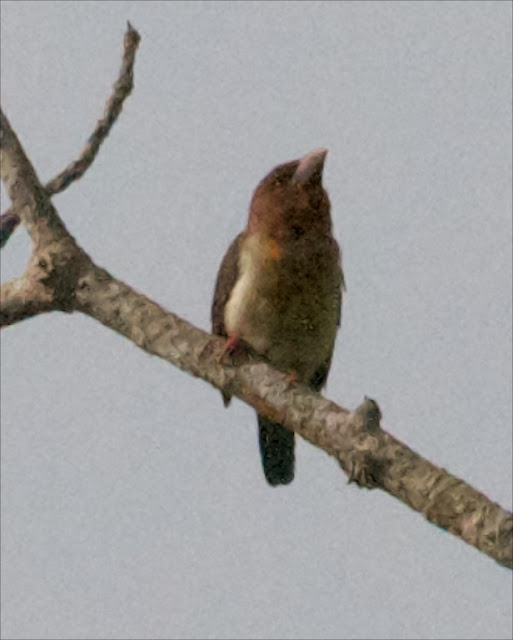
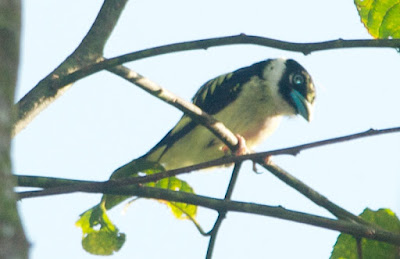



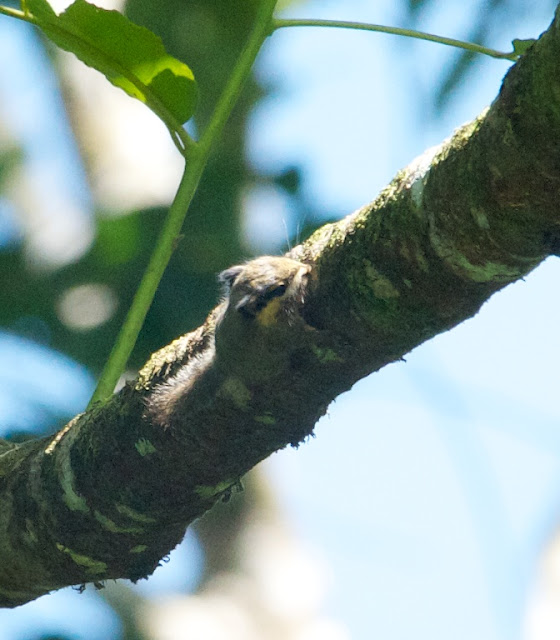




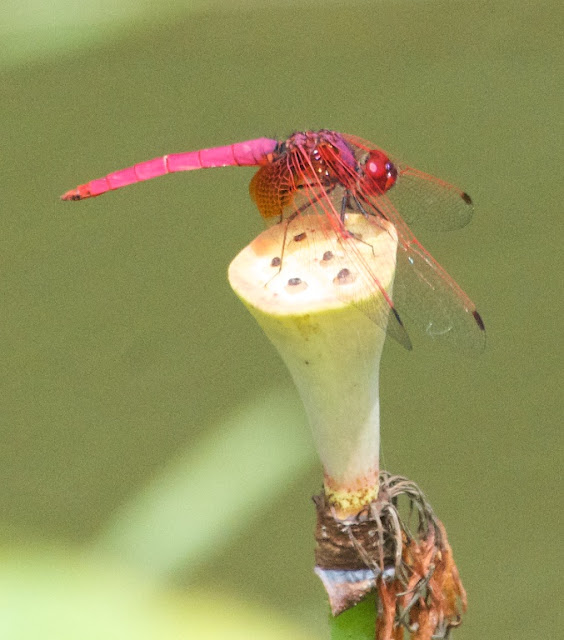





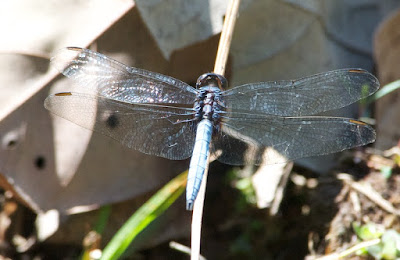




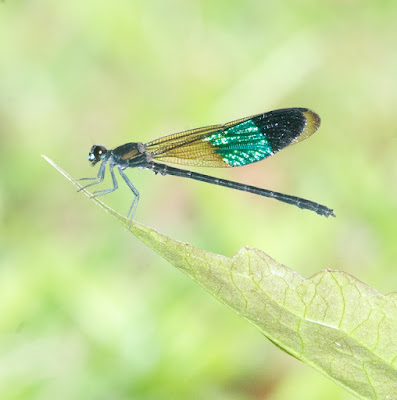









Muy bueno es un ecosistema increible saludos!!! no hay mejor terapia que la natualeza les mando un abrazo de Squamish british columbia un exelente lugar para observar los picidae.
ReplyDelete